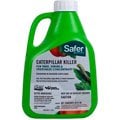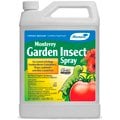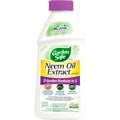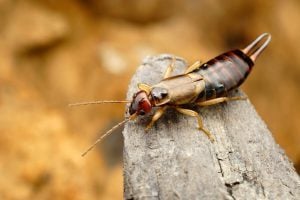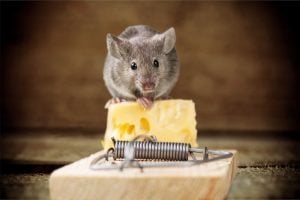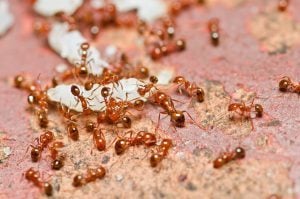What is the best way to get rid of caterpillars? There are two effective solutions suggested by scientists: biological control and insecticidal treatment. Biological control implies using natural enemies of caterpillars and parasites that are toxic to these insects. The most recommended products are those made with Spinosad and B.t. {Bacillus thuringiensis}— naturally occurring bacteria and their byproducts that are toxic to caterpillars. These active ingredients need to be consumed to be effective and are applied to the soil. When it comes to insecticides, they can be organic with plant-derived active ingredients, like pyrethrin and neem oil, or synthetic pesticides. The latter ones provide a longer insecticidal effect but can harm beneficial insects. Synthetic pesticides that are effective against caterpillar should contain such active ingredients as permethrin, bifenthrin, cyfluthrin, and malathion.
An American inventor Richard Buckminster Fuller once said: “There is nothing in a caterpillar that tells you it’s going to be a butterfly”. Indeed, the difference is striking, with the former being nothing short of a notorious crop pest and the latter being not just a beneficial insect but a beautiful creature that is so pleasing to our eyes. And yet, before this miraculous metamorphosis, a caterpillar has enough time to wreak havoc on your plot. Even more, the heavier the infestation is, the more serious damage is caused by these pests. This article covers scientists’ suggestions on how to get rid of caterpillars, various methods of pest control including how to kill caterpillars. You will learn which species are the most common in the USA as well as about the ways you can handle the problem, in particular, how to get rid of gypsy moth caterpillars. For your convenience, a comparison table of pest control measures is provided. Below you will find TOP 6 products available on for caterpillar control. According to scientists’ recommendations, we have made an emphasis on natural solutions.
{code 416}
- Caterpillar Damage
- What You Should Know About Caterpillars
- How To Get Rid Of Caterpillars
- How To Kill Caterpillars With Pesticides
- Methods of Caterpillar Control: Comparison Table
- TOP 6 Products Killing Caterpillars
Caterpillar Damage
Caterpillars can be found both indoors and outdoors. In particular, they prefer herbaceous plants, however, their diet varies and depends on the pest species. These pests consume cabbage, broccoli, kale and many other plants, vegetables and fruits. Since the eggs are laid on the undersides of the leaves, newly hatched caterpillars initially remain on the spot devouring the foliage and eventually skeletonizing it. With the further development, they abandon the cluster and start living on their own. At this stage, the pests eat holes amounting to 0.4 inches in size in leaves or cause some superficial damage to fruits.

It worth emphasizing that greenhouse owners have more reasons to bother with caterpillars because crops cultivated in such kind of structures are more vulnerable to these pests than crops grown in the open air. This is mainly due to the absence of pests’ natural enemies inside greenhouses that under natural conditions assist in caterpillar control. But this is not enough though. While birds feeding on these pests and wasps parasitizing their eggs is helpful, this is certainly no substitute for sustainable pest control. Bear in mind that openings in a greenhouse serve as entry points for moths which usually penetrate the structure in summer to lay eggs there. When hatched, the pests can chew on many kinds of plants and vegetables typically grown in greenhouses.
As a rule, the most susceptible plants to the damage are young seedlings as well as transplants while vegetables are much more tolerant. However, in extreme cases, heads of cabbage and broccoli will not be formed due to caterpillar destructive activity. In case of the heavy infestation, a major defoliation amounting up to 30 percent of the crop may be anticipated. Still, this primarily concerns young plants while older ones have proved to be more resistant.
What You Should Know About Caterpillars
As we have mentioned before, different species do not cause the same kind of injury to plants. There are a lot of them in the territory of the United States but not all of them are pests of trees and crops, therefore, let us focus on the most common ones. Note that you are dealing with larvae of moths and butterflies that dramatically change their appearance as they grow. One of the most notorious pests is the tent caterpillar which has received this name due to its habit of creating a protective silk web resembling a tent. They normally feed on apple, peach, plum, maple as well as cherry, therefore, if you have fruit trees in the garden, you might have definitely faced the problem of how to get rid of tent caterpillars. Apart from their peculiar “tents,” this species can also be distinguished from others by their defensive behavior. When disturbed, they are aggressive and emit a fluid. At a larval stage, the tent caterpillar is two inches in length and possesses hairs of the color ranging between yellow and brown. The body itself is pearl-gray with blue spots.

The peculiarity of the tobacco hornworm caterpillar is its big size amounting to five inches in length. These pests can easily defoliate tomato and pepper plants and they will do it very quickly before you know it! Many gardeners confess that tobacco hornworms have taken them aback when it was already too late. Apart from being easily identified because of its size, the tobacco hornworm larva has seven straight white stripes on each side of the body and a red horn in front of it. A similar species, the tomato hornworm, looks alike and have the same habits but differs in the color of the horn which is black. Also, they have different geographical distribution, with the tobacco hornworm mostly being encountered in the South of the USA and the tomato hornworm being common in the northern regions of the country.
The cabbage looper caterpillar consumes vegetable plants as you may have guessed from the name. They have green bodies with white stripes laterally but legless in the middle. The grown caterpillar is one and a half inches in length. You may also identify it by a characteristic habit of crawling across vegetation — by arching its body. These pests normally do not inflict a considerable damage but are known for their resistance to most pesticides, which is why it is hard to eradicate them.
You will never confuse the gypsy moth with other caterpillars as they have distinctive features not typical for other species. These are five pairs of blue dots and six pairs of red dots on the body which is dark and haired. Dwelling on how to get rid of gypsy moth caterpillars, take into consideration that the young ones are most active in the daytime whereas the old gypsy moth caterpillars are nocturnal. However, in case the outbreak is severe, the older ones may feed both at nighttime and during daylight hours. Gypsy moth caterpillars can become serious tree pests causing defoliation and increasing vulnerability to other pests. In particular, they feed on the foliage of oak, birch, apple, pine, basswood, spruce and other trees.
How To Get Rid Of Caterpillars
Researchers from the College of Agriculture, Health and Natural Resources at the University of Connecticut recommend the following habitat modification measures, especially when the matter concerns greenhouses and the area around the structure. The first step involves removing weeds that can be hosts for caterpillars. Secondly, clear plant debris out of garden periodically as they can become shelters for overwintering pupae. Thirdly, place screening so that moths will not be able to get in the greenhouses. How to get rid of caterpillars on trees? This problem relates essentially to tent caterpillars. Joe Collins from the Kentucky College of Agriculture suggests destroying their webbing which will help eradicate the population. To get better results, do it in early morning when the larvae caterpillar is still in the webbing. Do not burn these tents as you can hurt the tree. In case the tree is not tall, just prune off egg masses, however, for large trees or trees with numerous webbings, spraying insecticides will be needed.

Sometimes caterpillars devour foliage so quickly that urgent measures need to be taken, sometimes a gardener faces a mass infestation so that an integrated approach should be implemented. In small gardens, one may confine himself to handpicking caterpillars and dropping them in a jar of soapy water. However, this is extremely labor-intensive and in cases of heavy infestations is unrealizable. Charlotte Glen, an extension agent at Chatham County Center claims that most gardeners are unwilling to engage in such a menial work and stresses the effectiveness of pesticides. According to her, if you think about how to kill caterpillars, pesticides is the best bet. This also concerns some organic products which have an advantage of not being so noxious to beneficial insects and not having residues affecting the environment.
Natural enemies of caterpillars are abundant. They are not likely to eliminate the entire population but will certainly keep them low. According to scientists from the University of California, here are general predators, such as birds, lacewings, and spiders. But many natural enemies, like wasps and flies, are specific for each of the caterpillar species. For example, Trichogramma is tiny parasitoid wasps laying eggs right into the eggs of such species of the caterpillar as cabbage looper. It takes them about a week to develop into the adult, therefore, having purchased a package with one population you will soon have it increased manifold. A good way to save your money! However, these wasps are effective only against eggs, which is why the time of application is critical.
Apart from that, there are the Habrobracon, parasitic wasps feeding on caterpillars, the Tachinid fly, and others. Researchers from the Michigan State University Extension provide a list of natural enemies of gypsy moth. First, this is Ooencyrtus kuvanae, a small wasp parasitizing the eggs of gypsy moth. They have been well established in many regions of the United States for caterpillar biological control and are considered to be able to kill up to 30% of the eggs. Secondly, Cotesia, the wasps attack young gypsy moth caterpillars and can cause a high mortality among these pests.
How To Kill Caterpillars With Pesticides
Among biological pesticides, the most recommended ones for caterpillar control are products with B.t. and Spinosad as active ingredients. Bacillus thuringiensis, abbreviated as B.t., is soil-dwelling bacterium which targets caterpillars only. It is most effective against young caterpillars and is suggested for applying when the sun goes down because the substance degrades in sunlight. Since it is recommended as a solution against young pests, take care to use B.t. with the first signs of the damage, otherwise, it may be too late for this type of control. Scientists from the University of Minnesota Extension point out that B.t. targets specifically caterpillars and the pest has to eat the substance to be killed by the bacterium. Therefore, to obtain a result, you should treat the area thoroughly to make sure that the bacteria is in abundance in the soil. The downside of this active ingredient is in its short residual.

Another organic pesticide, Spinosad, is produced on the base of filamentous bacteria and is new on the market. Its effect lasts for up to five days, therefore it is a more long-lasting solution and has already received a lot of positive feedback. While these two substances are based on bacteria, there are other pesticides which are considered organic because of being derived from plants. This is Pyrethrin extracted from chrysanthemum, suggested for elimination numerous species of pests, not only caterpillars. Neem oil derived from the seeds of the same-name tree in India also targets multiple pests including caterpillars.
If you are among those who rely on chemical solutions, then your choice is synthetic pyrethroids based on such active ingredients as bifenthrin, cyfluthrin, malathion and permethrin. Dr. Ayanava Majumdar, Alabama Extension Entomologist, advise using cypermethrin for most caterpillar species but warns against over-spraying to avoid making pests resistant to the insecticide.
Synthetic pesticides have an advantage of lasting for a longer period of time but, at the same time, kills both pests and beneficial insects. When using pesticides, be sure to read carefully the label directions and precautions since when handled improperly such kind of products can pose a risk to humans, animals, and the environment. Moreover, it is illegal to use pesticides not in accordance with the label. This extends to storage conditions, amounts and the time of application. The latter is also crucial in that it influences the product’s impact on beneficial insects like bees which are usually active in the daytime.
Methods of Caterpillar Control: Comparison Table
Effectiveness Scale: 1 being the least, 10 being the most effective.
| Method | Type | Advantage | Disadvantage |
| Removing plant debris, weeds, installing screening
Effectiveness: 9 |
habitat modification | Protects plants in greenhouses; may be sufficient if the garden is not severely infested; a long-term solution. | Does not protect plants grown in the open air; labor-intensive. |
| Destroying webbing on trees
Effectiveness: 10 |
habitat modification | Helps drastically decrease the population of tent caterpillars; does not involve using chemicals; does not require extra spendings; a long-term solution. | This measure is relevant for tent caterpillar control only; labor-intensive. |
| Handpicking and dropping caterpillars in soapy water
Effectiveness: 7 |
killing | Effective in small gardens; does not require extra spendings. | Does not work in case of a heavy infestation; short-term solution; labor-intensive. |
| Natural enemies
Effectiveness: 9 |
killing | There is a wide range of caterpillar natural enemies; general predators like birds and spiders can be used against all species of caterpillars; parasitoids can rapidly reproduce that helps save money. | Parasitoid wasps and flies are effective only against each specific species of caterpillars; will not eradicate all caterpillars, but will rather keep the population low; some parasitoids are effective against eggs only, therefore, should be applied strictly in time. |
| Organic pesticides (B.t., Spinosad, Pyrethrin, Neem oil)
Effectiveness: 10 |
killing | Organic pesticides are not so toxic to beneficial insects as synthetic ones; eco-friendly; safe for humans; natural; scientists consider pesticides to be the most effective solution. | B.t. works only when ingested; the area should be sprayed generously; only Spinosad has a medium residual while B.t. and Pyrethrin have short residuals, therefore, should be applied more often during insect stage of development when foliage is being consumed. |
| Synthetic pesticides (bifenthrin, carbaryl, lambda-cyhalothrin, permethrin)
Effectiveness: 9 |
killing | A longer lasting solution (bifenthrin and carbaryl have a medium residual while lambda-cyhalothrin and permethrin have a medium-long residual, that is about two weeks); scientists consider pesticides to be the most effective solution. | Kills beneficial insects as well; can pose a hazard to humans, pets, and the environment. |
TOP 6 Products Killing Caterpillars
Below you will find TOP 6 products available on for caterpillar control. According to scientists’ recommendations, we have made an emphasis on natural solutions. These are wasps which are natural enemies of caterpillars as well as three options of organic insecticides. Two of them are based on bacteria, Bacillus thuringiensis and Spinosad, while the third one has an active ingredient Neem Oil which is a natural plant extract. These products have peculiarities in how they affect caterpillars but all of them are approved for organic gardening. Apart from that, there are two synthetic insecticides with active ingredients Permethrin and Bifenthrin which have longer residual but are more toxic.
Orcon TR-C3SQ Live Trichogramma, 12,000 Eggs
Trichogramma is a parasitoid wasp species which is one of the most commonly used for caterpillar control. This is a natural and absolutely safe way to protect your crop from these pests. What you need is to let nature do its job. The solution is particularly effective when applied inside greenhouses as there is a deficiency in beneficial insects. These wasps are natural predators of a number of caterpillar species including gypsy moth, alfalfa, cutworm, tomato hornworm caterpillars and some others. They lay their eggs inside the eggs of future caterpillars. Once hatched, the wasps consume the pest eggs and kill them. You will hardly see the moment when the adult wasp appear since it is a tiny insect with a short lifespan of about two week. But over the course of all these days, your newly born pest control assistants will be busy invading caterpillar eggs in your garden.
 And now we come to another advantage of the product which is cost efficient since adult wasps will reproduce on your plot. Therefore, it is safe to say that you purchase not just 12,000 eggs but make investments into future generation of these caterpillar exterminators. The drawback of the product is that Trichogramma attacks only eggs rather than grown caterpillars. This means that when not applied in time, the solution will not produce results. Also, you should not simultaneously use pesticides and Trichogramma because the former will likely kill these beneficial insects as well.
And now we come to another advantage of the product which is cost efficient since adult wasps will reproduce on your plot. Therefore, it is safe to say that you purchase not just 12,000 eggs but make investments into future generation of these caterpillar exterminators. The drawback of the product is that Trichogramma attacks only eggs rather than grown caterpillars. This means that when not applied in time, the solution will not produce results. Also, you should not simultaneously use pesticides and Trichogramma because the former will likely kill these beneficial insects as well.
Live Trichogramma rates 3.5 out of 5 stars. “I have been using Trichogramma in the garden since last year when my organic crops were nearly wiped out by an infestation of green caterpillars. The problem was that after removing those I could see more would hatch. Then I began using Trichogramma wasps and I haven’t seen a single green caterpillar since,” one of the customers says. However, he warns that not all caterpillars will be eliminated in the garden and “there is always a chance of something slipping through” And he is absolutely right noting that in nature predators never consume all prey, therefore some caterpillar may still show up after the wasps have been released.
Price: Check the current price
Safer Brand 5163 Caterpillar Killer II Concentrate, 16 oz
This concentrate is based on Bacillus thuringiensis (B.t.), bacteria killing a wide range of caterpillars, including gypsy moth, tomato hornworms and cabbage loppers. It works just like in the wild! When ingested, the bacterium releases a toxin preventing caterpillars them from feeding, and these pests eventually die. The solution is organic and eco-friendly, therefore, is safe for crops and much harmless to humans than conventional pesticides. The product is approved by the Organic Materials Review Institute (OMRI) and can be applied to edibles up until the day of harvest. By using organic pesticides, you will not only avoid harmful chemicals but will create a much healthier crop.
You can apply it to trees, shrubs, foliage of fruits and vegetables. What you need is to first dilute the concentrate with water and spray the mixture. The rest of the concentrate should be stored in compliance with the label directions. According to the manufacturer, one bottle of concentrate protects over 10,000 square feet of vegetation.
Safer Brand Caterpillar Killer has scored 4.6 out of 5 stars, with over 300 customer reviews the bulk of which are positive. “This worked super well. Saved our kale from cabbage white caterpillars, and made it a lot easier to harvest without having to pick off all the little caterpillars. Sometimes they would die and stay on the plant, they become white,” one user says.
Price: Check the current price
Monterey Garden Insect Spray with Spinosad Concentrate 32oz
This is another organic pesticide listed by OMRI but based on other active ingredient, Spinosad, a relatively new insecticide which is becoming increasingly popular among professionals and gardeners. It is a bacterial product produced by fermentation which can safely be sprayed upon fruits, vegetables, ornamental plants and turf. As soon as the substance is ingested by a caterpillar, it produces the result quite in a short period of time so that the target pests is killed within at most two days.
 Unlike the previous product, Monterey Spray targets not just caterpillars but some other pests as well. The product’s downside is that it is three times as expensive as Safer Brand but, at the same time, it is significantly larger in volume. The concentrate should be diluted with water at a ratio of 4 tablespoons per a gallon of spray. Apply the solution both to the upper side and underside of foliage. As for vegetable crops, the manufacturer suggests using at most three gallons of spray for 1,000 square feet.
Unlike the previous product, Monterey Spray targets not just caterpillars but some other pests as well. The product’s downside is that it is three times as expensive as Safer Brand but, at the same time, it is significantly larger in volume. The concentrate should be diluted with water at a ratio of 4 tablespoons per a gallon of spray. Apply the solution both to the upper side and underside of foliage. As for vegetable crops, the manufacturer suggests using at most three gallons of spray for 1,000 square feet.
Monterey Spray rates 4.4 out of 5 stars, with over 400 customer reviews. “For the past several years I have had an invasion of furry white caterpillars on my dogwoods in August. I bought this to see if it would work better than the soap based spray I had been using. The next day they were all dead and the trees have not been stripped bare as in previous years,” a satisfied customer shares his experience.
Price: Check the current price
Garden Safe Neem Oil Extract Concentrate, 16 fl oz
One more product intended for organic gardening is based on Neem Oil extract derived from seeds of the neem tree in India. This substance works by blocking the insect molting hormone that eventually kills the pest. Unlike the previous organic products, Neem Oil acts as insecticide targeting a wide range of insects including caterpillars, fungicide controlling fungal diseases, and miticide combating spider mites. Therefore, purchasing this product will be a good pennyworth for any gardener as pest problems never come singly.
 Being an organic pesticide, Neem Oil can be used up to day of harvest and applied to flowers, fruits, vegetables, as well as trees and shrubs. Although the product is natural, there are still some precautions to be taken. In particular, apply the solution in early morning or late evening to avoid burning leaves of the plants. Also, take into account that some plants are too sensitive to Neem Oil and should be excluded from the treated area.
Being an organic pesticide, Neem Oil can be used up to day of harvest and applied to flowers, fruits, vegetables, as well as trees and shrubs. Although the product is natural, there are still some precautions to be taken. In particular, apply the solution in early morning or late evening to avoid burning leaves of the plants. Also, take into account that some plants are too sensitive to Neem Oil and should be excluded from the treated area.
Neem Oil Extract rates 4.2 out of 5 stars, with almost 1,000 customer reviews the majority of which are positive. As for the product’s impact on caterpillars, opinions have divided. Some users say that the stuff works while others disagree claiming it to be ineffective against some species like grape leaffolders caterpillars. “I use it on the little green caterpillars we get in Florida that eat leaves, stems, and through the vegetables. It kills on contact, but is definitely not as strong,” one customer notes.
Price: Check the current price
Tengard SFR One-Shot Liquid Termiticide Insecticide, 32 oz
Among synthetic pesticides commercially available for homeowners, there is Tengard SFR, an insecticide based on synthetic Permethrin. The product is labeled for a number of pests including caterpillars. Why should you consider using synthetic pesticide if there are environmentally friendly options? Well, its major advantage over organic pesticides is in residual persisting as long as two weeks. In other words, the effect is longer and stronger. Also, despite being a chemical substance, Tengard SFR is odorless. However, it has two major disadvantages. The first one is that the stuff kills beneficial insects which are useful for gardening on the whole, with some of them being natural enemies of caterpillars. The second drawback is that the product distribution is restricted and not available in some states due to its long residual. The longer residual is, the longer the poisonous substance remains in the soil, with the probability of getting into water sources after rains.
The active ingredient Permethrin accounts for 36.80% of the liquid, that is its concentration is very high. One bottle makes up 96 gallons of outdoor spray at a ration of 1/3 rd of a fluid ounce per gallon. So, it is safe to assume that the product is cost-efficient and very practical. Tengard SFR has scored 4.7 out of 5 stars. Unfortunately, there is no feedback regarding caterpillar control but the bulk of all reviews are positive, therefore, is considered effective by consumers.
Price: Check the current price
Bifen XTS 25.1% 32 oz
Since scientists recommend Bifenthrin-based products as a chemical option for caterpillar control, we have also included Bifen XTS containing this active ingredient in the review. As a reference, Bifenthrin works by interrupting the nervous system of pests and has a quick knockdown effect. The product provides a long residual and has a strong concentration of Bifenthrin — 25,1%. It does not have a pronounced strong odor, something that can be considered an advantage when the matter concerns chemicals. One of the major drawbacks is that the solution is not labeled for fruit trees or edible plants, which is where caterpillars normally feed and cause damage.
Perhaps, Bifen XTS is the most popular product among those mentioned in the review. It rates 4.7 out of 5 stars, with over 700 customer reviews, only 40 of which are critical. Although caterpillars are not mentioned among target pests in the product description, there is consumer feedback on caterpillar control. This actually means that the product has been purchased for this purpose and there are consumer experiences to analyze.
Well, one customer tells about using Bifen against tent caterpillars and claims having “a great success”. Another user has applied the solution against brown caterpillars in the house. “I’ve used it as directed twice and haven’t seen as many. But there are still a few,” he notes. One more customer gives some advice on the product application: “Caterpillars are killed on contact. The adults are tough, but you can retreat 2 weeks later to break the lifecycle if you still see feeding. Be sure to use enough water to get to the soil surface. That is where the caterpillar stage sleeps during the day,”. So, based on the feedback, we can conclude that Bifen generally works against caterpillars but does not eradicate the entire population, what is also true for other solutions though. In addition, take into account that this is a heavy insecticide which should be handled, stored and applied very carefully.
Price: Check the current price
Top 6 Caterpillar Killing Products: Comparative Chart
{code 416}
{code 294}


